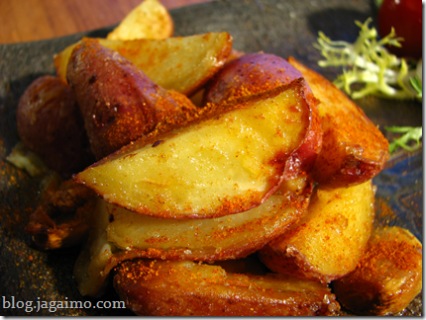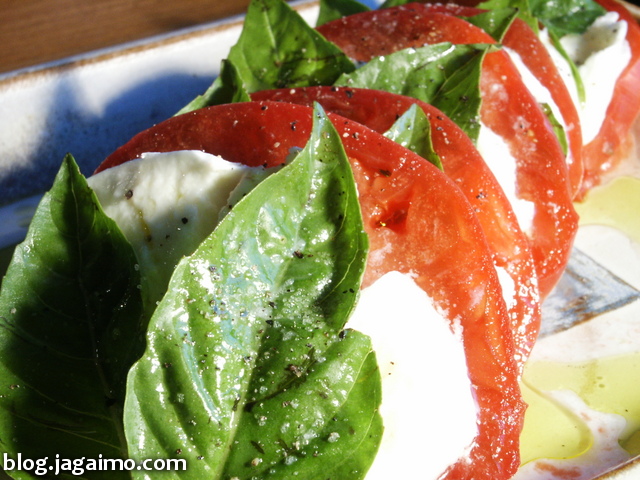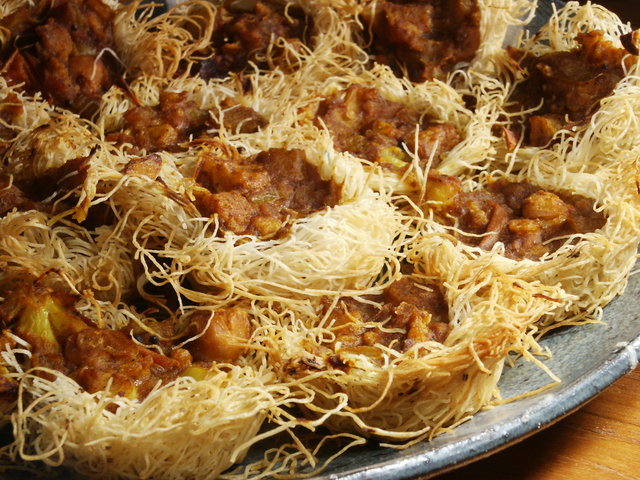After a run of Japanese food, I started craving pastas and breads again. Somehow an urge to do something with mustard greens kicked in. A weekend trip to the supermarket with no particular time pressure put me in a playful mood.
I thought about the Nagano specialty oyaki I sometimes make with mustard greens.
I tried making some beggar's purses on a whim, but realized the wrappers I rolled out were a little too thick. So for the next batch, I chose to make thinner, ravioli-like dumplings.
When I go through the trouble of making stuffed pasta at home, the last thing on my mind is recreating something that I could easily acquire at a supermarket or local Italian specialty shop. So I either go the route of using much better quality ingredients than I'd ever find in the fillings made by one of those fresh pasta making companies, or take the opportunity to play with combinations that I'd be unlikely to find anywhere else.
This was an occasion for the latter.
For the filling, I rub some washed mustard greens with coarse salt and let them sit for five or then minutes, then I come back to rinse them and squeeze out excess moisture. They shrink nicely, and I add some soft manouri cheese, a tangy sheep's milk cream cheese from Greece. I grate a little nutmeg in, then work an egg yolk into the mixture, along with a spoonful of bread crumbs. I might have added a little black pepper.
Soft ravioli filled with mustard greens and manouri cheese

I chose to make these with regular wheat, rather than hard semolina flour. Durum wheat pasta, or semolina pasta, is more common in the US, thanks in part to the strong southern Italian influence in Italian-American cuisine, not to mention its advantages to pasta manufacturers. But much of northern Italy actually prefers pasta made with ordinary wheat, and both Chinese and Eastern European cooking is full of noodles made with soft or hard all-purpose flour.
Unlike those with the luxury of an extravagant, beautiful exhibition-like kitchen, I have no room for a pasta maker in my home. I'm not really sure I even have room for the things already spilling out of my tiny cupboards. So I relied entirely on manual labor.
I start with a hand-kneaded pasta dough made from flour, egg yolks, a hint of freshly grated nutmeg, and a pinch of salt. The dough rests for an hour or so.
Then I divide the dough into manageable chunks that I can roll out on my limited counter-space, dusting with flour as needed to keep things from getting too sticky. I flip the dough a few times and do whatever I can to achieve a fairly even thickness.
A cookie-cutter comes to the rescue when I want to cut out round pasta shapes. Or rather, it would have, were I able to remember where my one round cookie cutter was stashed. The urgent need for improvisation leads me to a suitably-sized plastic lid from a spice jar, which has just enough sharpness to do the trick.
I top one half of the pasta circles with a small amount of filling, rub each outer edge with some water, and seal the ravioli shut with one of the unused circles.
During the summer I often want lighter sauces than I typically rely on during colder weather. So rather than some heavy cream sauce, or even a big marinara sauce that might compete with the flavor of the filling, I played with a sauce constructed upon an inexpensive, moderately dry Chateau Ste. Michelle Gewurztraminer.
I simmer the wine with a little porcini-kombu soup stock for several minutes, then added some butter and salt. Initially, the flavor is a bit acidic, but the butter goes a long way to mellow out the wine. As the pasta boils, I toss some shimeji mushrooms into the wine sauce.
When the pasta looks ready to go, I strain the ravioli and let them simmer briefly in the sauce.
You may want to add a little shaved parmesan or black pepper. Since dinner had other sources of cheese, I kept it simple.
The sauce is lively with slightly herbal notes, and just rich enough to cut the acidity of the wine without weighing it down.
The Gewurztraminer has enough complexity to mitigate the need for aromatics like garlic or onions, especially with those intense mustard greens. I also had an audience that appreciates light, sappari flavors and I was serving a few other dishes to provide a balance of intense and light flavors.
However, if you wanted this to be the main focal point a meal you might work in some caramelized shallots, either finely minced and worked into the sauce, or simply sliced and presented as a final touch to top the pasta.
Technorati tags:
food,
pasta,
homemade pasta,
ravioli,
mustard greens,
manouri,
cheese,
wine,
wine sauce,
Gewurztraminer,
Chateau Ste. Michelle











